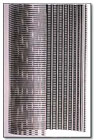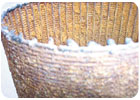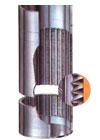
Continuous slot screen is manufactured by wrapping a shaped wire around an internal array of longitudinal rods. The wire and rod, generally made from carbon or stainless steel, are joined by resistance welding. Photo courtesy of Roscoe Moss Co.
Well Screen Requirements
Over the years, many different types of screens have been developed to meet the varied requirements of water wells. Common sense suggests that there is no single type best for all conditions. Well screen types have different attributes and characteristics, and may be equal in some respects, but unequal in others. To assist in evaluation, the following general requirements are set forth:- The well screen should have the largest possible aperture size consistent with retaining the filter pack in a gravel envelope well, or formation material in non-gravel envelope wells.
- The internal configuration of the screen should facilitate well development and redevelopment through accommodation of the most effective mechanical methods available, such as tight swabbing.

Encrusted minerals on the inside of a totally plugged well screen. Photo courtesy of the North Dakota State University Extension Service.
Economic Considerations
Economy not only is a general consideration, but a special one - especially if cost dictates the use of less screen or screening of intervals only in gravel envelope wells. These practices have had unfortunate results in many cases. Often, even if the best sampling procedures are followed and electric logging performed and interpreted, selective screening can result in inadvertent blanking off of productive aquifers. Another important consideration is the bridging tendency of gravel at the top of any screen section. It is difficult - sometimes impossible - to consolidate gravel behind blank casing. Possible outcomes include sand pumping or sealing off of water through sloughing of impervious material against the aquifers. This does not apply to the bottom of the well where a 10-foot to 20-foot section of blank casing should be installed to provide a basin for sediment material.
No single component affects maintenance, long-term performance and long life of a well more than the well screen. Photo courtesy of Chemdrex Chemicals.
Entrance Velocity
Proper screen design minimizes frictional head losses associated with the entrance of water into the well. This point has been overemphasized in the past, with virtues claimed for screens with the highest area of opening (lowest entrance velocity), which have not been confirmed by field data. Extensive research, including mathematical analysis, review of practical experience and extensive model testing, has established that entrance velocities up to 3.5 feet per second result in minimal head losses. An important factor in determining actual entrance velocity, however, is the “effective area of opening,” which may be less than the measured opening due to plugging or invasion of fine material. This usually is the result of poor gravel pack and/or slot size selection. The screen opening should be designed to minimize this possibility. While there have been many statements concerning the role of entrance velocity through a screen with respect to corrosion and encrustation, the body of field and theoretical evidence does not prove any relationship with respect to the usual range of velocities through commonly used screens.Actually, velocities from 1 foot to 5 feet per second are considered beneficial in pipelines. Higher velocities often cause a combination of corrosion and erosion, which may be very severe. This condition occurs in wells where most screen openings have been encrusted, leaving the water to be produced from a sporadic few. In addition to losses in production and well efficiency, high entrance velocities through these perforations can cause rapid enlargement and frequent failure. Proper screen configuration and sufficient area of opening mitigate this problem.
Report Abusive Comment